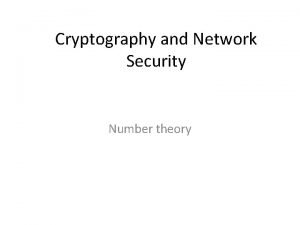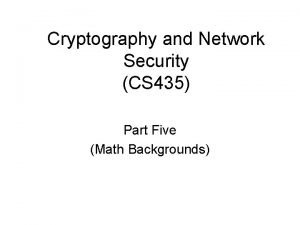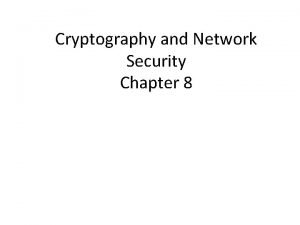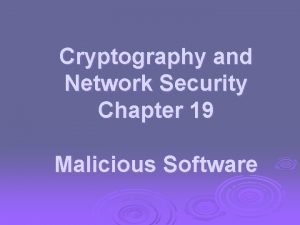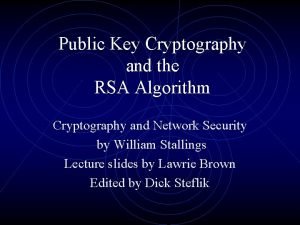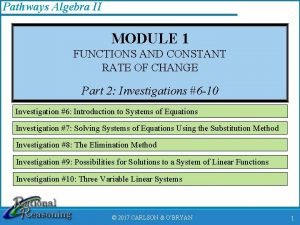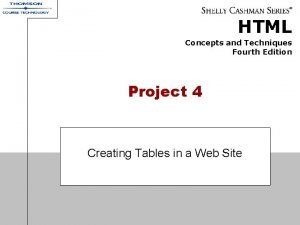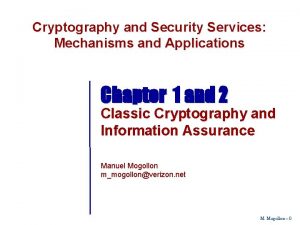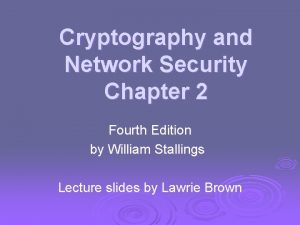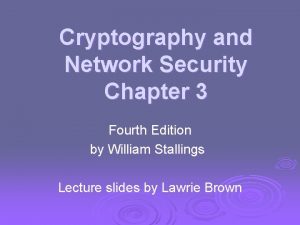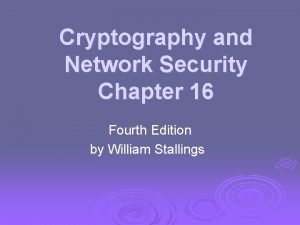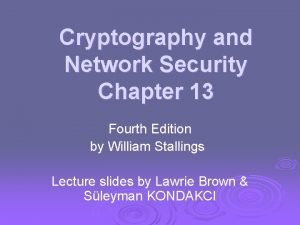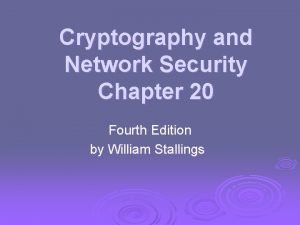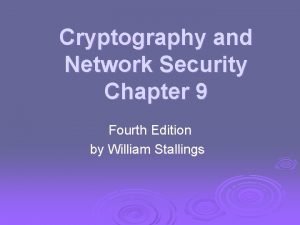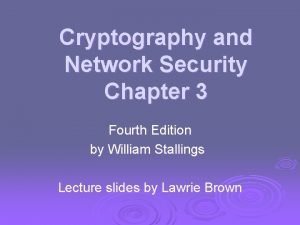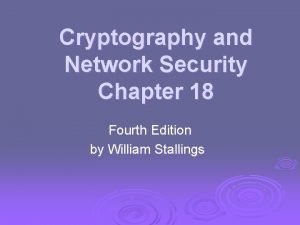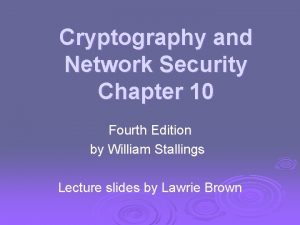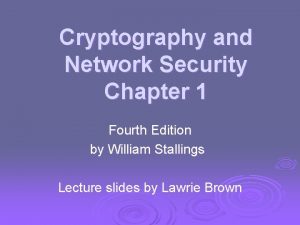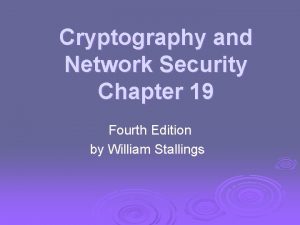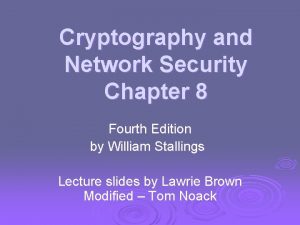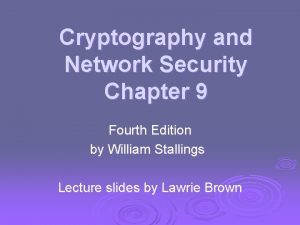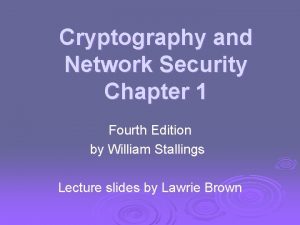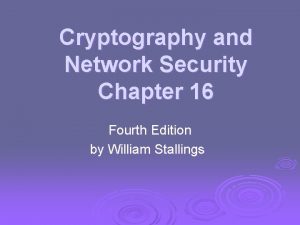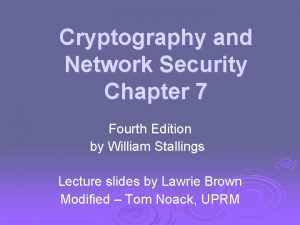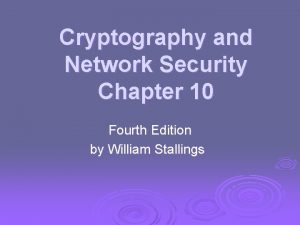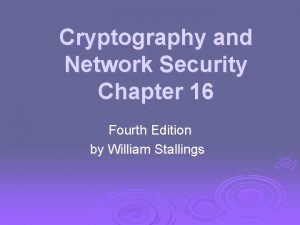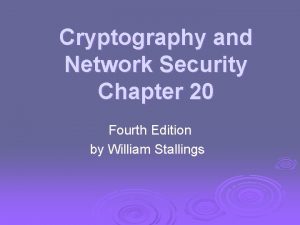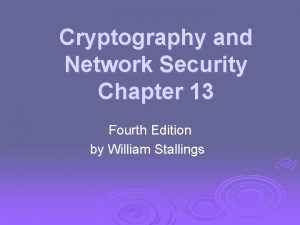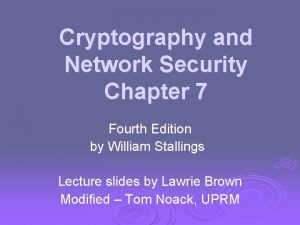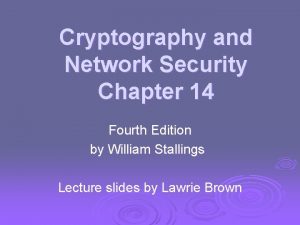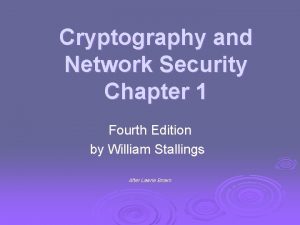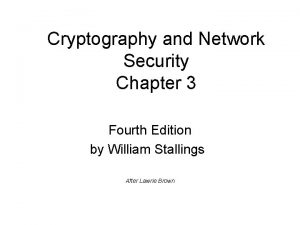Cryptography and Network Security Chapter 6 Fourth Edition
































- Slides: 32

Cryptography and Network Security Chapter 6 Fourth Edition by William Stallings Lecture slides by Lawrie Brown

Chapter 6 – Contemporary Symmetric Ciphers "I am fairly familiar with all the forms of secret writings, and am myself the author of a trifling monograph upon the subject, in which I analyze one hundred and sixty separate ciphers, " said Holmes. —The Adventure of the Dancing Men, Sir Arthur Conan Doyle

Multiple Encryption & DES clear a replacement for DES was needed l theoretical attacks that can break it l demonstrated exhaustive key search attacks Ø AES is a new cipher alternative Ø prior to this alternative was to use multiple encryption with DES implementations Ø Triple-DES is the chosen form Ø

Double-DES? could use 2 DES encrypts on each block l C = EK 2(EK 1(P)) Ø issue of reduction to single stage Ø and have “meet-in-the-middle” attack l works whenever use a cipher twice l since X = EK 1(P) = DK 2(C) l attack by encrypting P with all keys and store l then decrypt C with keys and match X value 56) steps l can show takes O(2 Ø

Triple-DES with Two-Keys Ø Ø hence must use 3 encryptions l would seem to need 3 distinct keys but can use 2 keys with E-D-E sequence l C = EK 1(DK 2(EK 1(P))) l nb encrypt & decrypt equivalent in security l if K 1=K 2 then can work with single DES standardized in ANSI X 9. 17 & ISO 8732 no current known practical attacks

Triple-DES with Three-Keys although are no practical attacks on two-key Triple-DES have some indications Ø can use Triple-DES with Three-Keys to avoid even these l C = EK 3(DK 2(EK 1(P))) Ø has been adopted by some Internet applications, eg PGP, S/MIME Ø

Modes of Operation Ø Ø Ø block ciphers encrypt fixed size blocks l eg. DES encrypts 64 -bit blocks with 56 -bit key need some way to en/decrypt arbitrary amounts of data in practise ANSI X 3. 106 -1983 Modes of Use (now FIPS 81) defines 4 possible modes subsequently 5 defined for AES & DES have block and stream modes

Electronic Codebook Book (ECB) Ø Ø message is broken into independent blocks which are encrypted each block is a value which is substituted, like a codebook, hence name each block is encoded independently of the other blocks Ci = DESK 1(Pi) uses: secure transmission of single values

Electronic Codebook Book (ECB)

Advantages and Limitations of ECB message repetitions may show in ciphertext l if aligned with message block l particularly with data such graphics l or with messages that change very little, which become a code-book analysis problem Ø weakness is due to the encrypted message blocks being independent Ø main use is sending a few blocks of data Ø

Cipher Block Chaining (CBC) Ø Ø Ø message is broken into blocks linked together in encryption operation each previous cipher blocks is chained with current plaintext block, hence name use Initial Vector (IV) to start process Ci = DESK 1(Pi XOR Ci-1) C-1 = IV uses: bulk data encryption, authentication

Cipher Block Chaining (CBC)

Message Padding Ø at end of message must handle a possible last short block l which is not as large as blocksize of cipher l pad either with known non-data value (eg nulls) l or pad last block along with count of pad size • eg. [ b 1 b 2 b 3 0 0 5] • means have 3 data bytes, then 5 bytes pad+count this may require an extra entire block over those in message Ø there are other, more esoteric modes, which avoid the need for an extra block l

Advantages and Limitations of CBC a ciphertext block depends on all blocks before it Ø any change to a block affects all following ciphertext blocks Ø need Initialization Vector (IV) Ø l l which must be known to sender & receiver if sent in clear, attacker can change bits of first block, and change IV to compensate hence IV must either be a fixed value (as in EFTPOS) or must be sent encrypted in ECB mode before rest of message

Cipher Feed. Back (CFB) Ø Ø Ø message is treated as a stream of bits added to the output of the block cipher result is feed back for next stage (hence name) standard allows any number of bit (1, 8, 64 or 128 etc) to be feed back l denoted CFB-1, CFB-8, CFB-64, CFB-128 etc most efficient to use all bits in block (64 or 128) Ci = Pi XOR DESK 1(Ci-1) C-1 = IV uses: stream data encryption, authentication

Cipher Feed. Back (CFB)

Advantages and Limitations of CFB Ø Ø Ø appropriate when data arrives in bits/bytes most common stream mode limitation is need to stall while do block encryption after every n-bits note that the block cipher is used in encryption mode at both ends errors propogate for several blocks after the error

Output Feed. Back (OFB) Ø Ø Ø message is treated as a stream of bits output of cipher is added to message output is then feed back (hence name) feedback is independent of message can be computed in advance Ci = Pi XOR Oi Oi = DESK 1(Oi-1) O-1 = IV Ø uses: stream encryption on noisy channels

Output Feed. Back (OFB)

Advantages and Limitations of OFB bit errors do not propagate Ø more vulnerable to message stream modification Ø a variation of a Vernam cipher Ø l hence must never reuse the same sequence (key+IV) sender & receiver must remain in sync Ø originally specified with m-bit feedback Ø subsequent research has shown that only full block feedback (ie CFB-64 or CFB-128) should ever be used Ø

Counter (CTR) a “new” mode, though proposed early on Ø similar to OFB but encrypts counter value rather than any feedback value Ø must have a different key & counter value for every plaintext block (never reused) Ci = Pi XOR Oi Oi = DESK 1(i) Ø uses: high-speed network encryptions Ø

Counter (CTR)

Advantages and Limitations of CTR Ø Ø efficiency l can do parallel encryptions in h/w or s/w l can preprocess in advance of need l good for bursty high speed links random access to encrypted data blocks provable security (good as other modes) but must ensure never reuse key/counter values, otherwise could break (cf OFB)

Stream Ciphers process message bit by bit (as a stream) Ø have a pseudo random keystream Ø combined (XOR) with plaintext bit by bit Ø randomness of stream key completely destroys statistically properties in message Ø l Ø Ci = Mi XOR Stream. Keyi but must never reuse stream key l otherwise can recover messages (cf book cipher)

Stream Cipher Structure

Stream Cipher Properties Ø Ø Ø some design considerations are: l long period with no repetitions l statistically random l depends on large enough key l large linear complexity properly designed, can be as secure as a block cipher with same size key but usually simpler & faster

RC 4 Ø Ø Ø a proprietary cipher owned by RSA DSI another Ron Rivest design, simple but effective variable key size, byte-oriented stream cipher widely used (web SSL/TLS, wireless WEP) key forms random permutation of all 8 -bit values uses that permutation to scramble input info processed a byte at a time

RC 4 Key Schedule starts with an array S of numbers: 0. . 255 Ø use key to well and truly shuffle Ø S forms internal state of the cipher Ø for i = 0 to 255 do S[i] = i T[i] = K[i mod keylen]) j = 0 for i = 0 to 255 do j = (j + S[i] + T[i]) (mod 256) swap (S[i], S[j])

RC 4 Encryption encryption continues shuffling array values Ø sum of shuffled pair selects "stream key" value from permutation Ø XOR S[t] with next byte of message to en/decrypt Ø i = j = 0 for each message byte Mi i = (i + 1) (mod 256) j = (j + S[i]) (mod 256) swap(S[i], S[j]) t = (S[i] + S[j]) (mod 256) Ci = Mi XOR S[t]

RC 4 Overview

RC 4 Security claimed secure against known attacks l have some analyses, none practical Ø result is very non-linear Ø since RC 4 is a stream cipher, must never reuse a key Ø have a concern with WEP, but due to key handling rather than RC 4 itself Ø

Summary Triple-DES Ø Modes of Operation l ECB, CBC, CFB, OFB, CTR Ø stream ciphers Ø RC 4 Ø
 Cryptography and network security 6th edition
Cryptography and network security 6th edition Cryptography and network security 6th edition pdf
Cryptography and network security 6th edition pdf Cryptography and network security 4th edition
Cryptography and network security 4th edition Cryptography and network security pearson
Cryptography and network security pearson Wireless security in cryptography
Wireless security in cryptography криптографический модуль
криптографический модуль Number theory in cyber security
Number theory in cyber security Firewall in cryptography and network security
Firewall in cryptography and network security Authentication in cryptography and network security
Authentication in cryptography and network security Intruders in cryptography
Intruders in cryptography Primitive root
Primitive root Euler's theorem in cryptography and network security
Euler's theorem in cryptography and network security Euler's theorem in cryptography and network security
Euler's theorem in cryptography and network security Finite fields in cryptography and network security
Finite fields in cryptography and network security Dsa in network security
Dsa in network security Gcd(1970,1066)
Gcd(1970,1066) Pgp in cryptography and network security
Pgp in cryptography and network security Euler's theorem in cryptography and network security
Euler's theorem in cryptography and network security Malicious software in cryptography and network security
Malicious software in cryptography and network security Introduction to cryptography and network security
Introduction to cryptography and network security Rsa algorithm in cryptography and network security
Rsa algorithm in cryptography and network security Introduction to cryptography and network security
Introduction to cryptography and network security Expert systems: principles and programming, fourth edition
Expert systems: principles and programming, fourth edition William stallings network security essentials 5th edition
William stallings network security essentials 5th edition Cryptographic systems are generically classified by
Cryptographic systems are generically classified by Project 2 fourth edition
Project 2 fourth edition Algebra 2 module 1 answer key
Algebra 2 module 1 answer key Ethics in information technology fourth edition
Ethics in information technology fourth edition Ethics in information technology 6th edition answers
Ethics in information technology 6th edition answers Vertical line code in html
Vertical line code in html Susanna s epp
Susanna s epp Provate security
Provate security Security services in cryptography
Security services in cryptography












